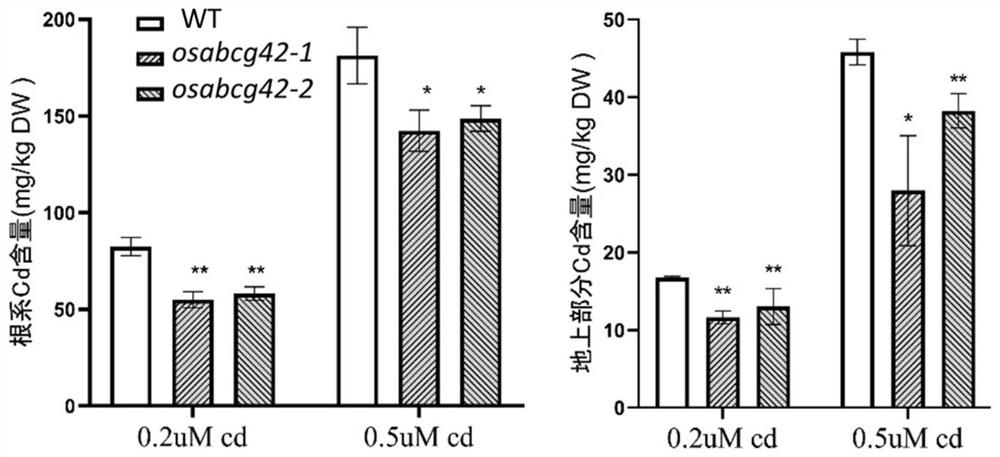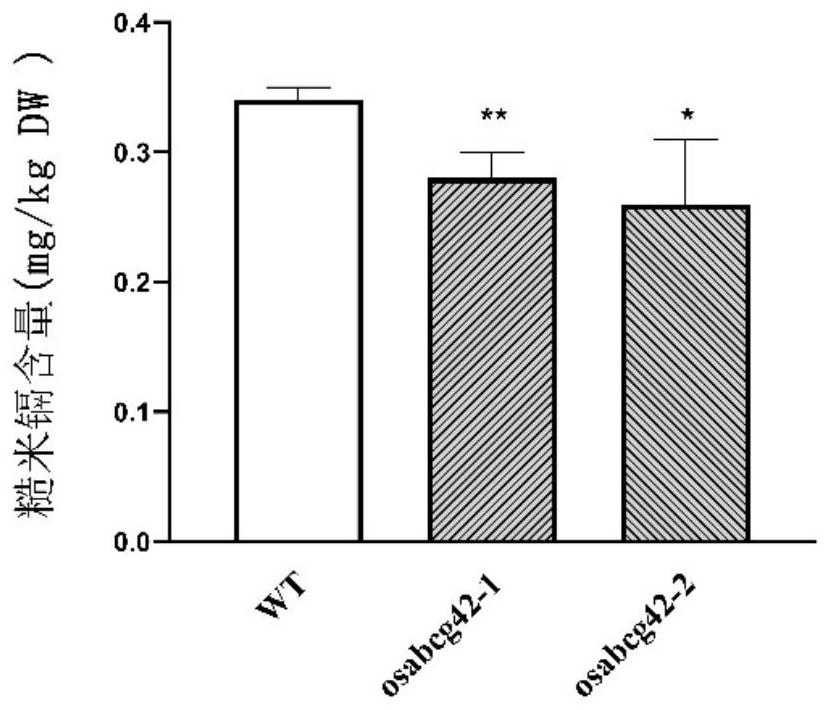The gene osabcg42 regulating cadmium accumulation in rice, its encoded protein and its application
A technology for encoding protein and rice cadmium, applied in the field of the gene OsABCG42 and its encoded protein that regulates the accumulation of rice cadmium, to achieve the effect of simple operation, short cycle, and improved cadmium accumulation characteristics
- Summary
- Abstract
- Description
- Claims
- Application Information
AI Technical Summary
Problems solved by technology
Method used
Image
Examples
Embodiment 1
[0033] A gene OsABCG42 regulating rice cadmium accumulation of the present invention has a nucleotide sequence of its coding region as shown in SEQ ID NO: 1, specifically:
[0034]ATGATACTGGGATTGGATATATGCGCGGACACGATCGTCGGCGACCAGATGCAGAGGGGGATCTCCGGTGGTCAGAAGAAACGCGTCACCACCGGTGAGATGATTGTCGGTCCAACAAAGGTTCTATTCATGGATGAGATATCAACTGGATTGGACAGCTCCACCACATTCCAGATTGTCAAATGCCTTCAGCAAATCGTGCACTTGGGCGAGGCAACCATCCTCATGTCACTCCTACAACCAGCCCCTGAGACTTTTGAGCTATTCGATGACATTATCCTACTGTCAGAAGGCCAGATTGTTTATCAGGGACCCCGCGAATACGTCCTTGAGTTCTTTGAGTCATGCGGATTCCGCTGCCCAGAGCGTAAGGGTACTGCAGACTTTCTTCAGGAGGTGACATCAAAGAAGGATCAGGAGCAGTATTGGGCCGACAAGCATAGGCCATACAGATACATTTCAGTCTCAGAATTTGCACAGAGATTTAAAAGGTTCCATGTTGGGCTCCAACTTGAGAATCATCTCTCAGTCCCATTTGATAAAACTCGTAGCCATCAGGCTGCTCTTGTCTTCTCGAAGCAATCGGTGTCAACAACAGAGCTCCTCAAGGCATCCTTTGCCAAGGAGTGGCTCCTCATTAAGCGCAACTCATTTGTGTACATCTTCAAGACCATACAGCTCATCATTGTAGCCCTTGTCGCGTCGACAGTGTTTCTTAGGACCCAGATGCACACAAGGAATTTAGATGATGGCTTTGTGTACATTGGAGCACTACTTTTCAGTCTGATTGTGAACATGTTCAATGGTTTCGCTG...
Embodiment 2
[0038] Example 2: Obtainment and molecular identification of OsABCG42 knockout strain
[0039] A method for suppressing the expression of the gene OsABCG42 of the present invention specifically comprises: editing the CDS of the OsABCG42 gene by CRISPR / Cas9 to cause a nonsense mutation in OsABCG42. The specific implementation method is as follows:
[0040] (1) According to the selection principle of the target site of the CRISPR / Cas9 vector system, two 20bp sequences were selected in the third exon of OsABCG42 as the target sequence for the generation of sgRNA.
[0041] The first target sequence is located in the antisense strand 189-208bp downstream of the start codon ATG in the coding region of the OsABCG42 gene, and the sequence is CCAAGTGCACGATTTGCTGA (as shown in SEQ ID NO: 3);
[0042] The second target sequence is located in the antisense strand 317-336 bp downstream of the start codon ATG in the coding region of the OsABCG42 gene, and the sequence is GAACTCAAGGACGTATTC...
Embodiment 3
[0059] Example 3: Element content and main agronomic traits of OsABCG42 gene knockout lines
[0060] Detection of Cd content in aerial parts and roots of OsABCG42 knockout lines: OsABCG42 knockout lines osabcg42-1, osabcg42-2 and wild-type control Huazhan were sown in 96-well PCR plates with the bottom cut off after soaking and accelerating germination. Nutrient solution cultured for 14 days, with 0.2, 0.5μM CdCl 2 Treat for 10 days, rinse with tap water and deionized water three times, separate the aboveground part from the root system, dry at 80°C until constant weight, crush, weigh, and use HNO 3 -HClO 4 The mixture was digested, and the Cd content in aerial parts and roots was measured by inductively coupled plasma mass spectrometer (ICP-MAS).
[0061] The result is as figure 2 As shown in the figure, it can be seen from the figure that the cadmium content in the aerial parts and roots of the knockout lines osabcg42-1 and osabcg42-2 were significantly reduced under the...
PUM
 Login to View More
Login to View More Abstract
Description
Claims
Application Information
 Login to View More
Login to View More - R&D
- Intellectual Property
- Life Sciences
- Materials
- Tech Scout
- Unparalleled Data Quality
- Higher Quality Content
- 60% Fewer Hallucinations
Browse by: Latest US Patents, China's latest patents, Technical Efficacy Thesaurus, Application Domain, Technology Topic, Popular Technical Reports.
© 2025 PatSnap. All rights reserved.Legal|Privacy policy|Modern Slavery Act Transparency Statement|Sitemap|About US| Contact US: help@patsnap.com



